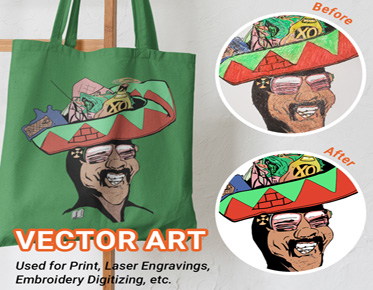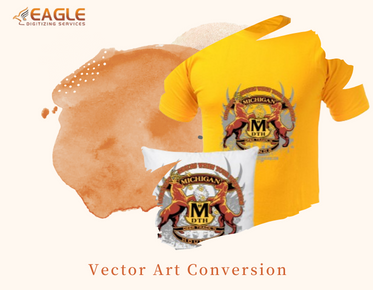Is Vector Art the Secret to Perfect Lifelong Monograms?
Vector art, which utilizes mathematical equations to create images, ensures that monograms maintain their quality at any size. Unlike raster graphics, which can become pixelated when resized, vector graphics remain sharp and clear. This precision is crucial for monograms, which often require intricate details and fine lines. Vector art's scalability and versatility make it an ideal choice for creating lasting and adaptable monogram designs.
Getting Started with Vector Art
Understanding Vector Graphics: The Basics
Vector graphics are created using paths defined by mathematical formulas rather than pixels. These paths consist of points, lines, and curves, which can be scaled infinitely without losing resolution. This method of image creation allows for smooth edges and clean lines, making it perfect for detailed designs like monograms. Understanding these fundamentals will enable you to harness the full potential of vector art in your projects.
Benefits of Using Vector Art for Monograms
The main advantage of vector art is its scalability. Monograms designed in vector format can be resized from a small embroidery on a handkerchief to a large wall decal without any loss in quality. Additionally, vector graphics are editable, allowing for easy modifications and refinements. This flexibility ensures that your monogram can be adapted for various applications and formats, maintaining its integrity across different mediums.
Essential Tools for Vector Art Creation
To create vector art, you need specialized software and tools. Essential tools include vector drawing applications, a high-quality graphic tablet for precise input, and a reliable computer with sufficient processing power. Familiarizing yourself with these tools and their functionalities will streamline your design process and enhance your ability to produce professional-grade monograms.
Choosing the Right Software
Overview of Popular Vector Editing Software
Several software options are available for creating vector art, each with unique features. Adobe Illustrator, CorelDRAW, and Inkscape are among the most popular choices. Adobe Illustrator is renowned for its comprehensive set of tools and professional capabilities. CorelDRAW offers a user-friendly interface with powerful design features. Inkscape, a free and open-source option, provides a robust set of tools suitable for most vector design needs.
Comparing Adobe Illustrator, CorelDRAW, and Inkscape
Adobe Illustrator is a top-tier choice for professional designers, offering extensive features and industry-standard tools. CorelDRAW, while also professional, is known for its intuitive interface and ease of use. Inkscape, although free, provides a surprising range of features and flexibility. Your choice will depend on your budget, design needs, and personal preferences. Each software has its strengths, so consider which aligns best with your workflow.
Free vs. Paid Software: What’s Best for Monograms?
Free software like Inkscape can be an excellent starting point for those new to vector art or on a budget. It offers many of the essential features needed to create high-quality monograms. However, paid software like Adobe Illustrator or CorelDRAW provides advanced tools and support that may be beneficial for more intricate designs or professional projects. Weighing the cost against the features and support offered will help you choose the best option for your monogram creation.
Designing Your Monogram: Initial Steps
Brainstorming and Sketching Your Ideas
Before diving into digital design, spend time brainstorming and sketching your monogram ideas. This stage allows you to experiment with various combinations of initials, shapes, and styles. Hand-drawn sketches can serve as a blueprint for your digital design, helping you visualize how different elements will come together in your final monogram.
Selecting Fonts and Typography
Choosing the right fonts is crucial in monogram design. Typography can significantly influence the overall look and feel of your monogram. Opt for fonts that complement your design and reflect the personality you want to convey. Serif fonts offer a classic and sophisticated look, while sans-serif fonts provide a modern and clean appearance. Experiment with different typefaces to find the perfect fit for your design.
Incorporating Personal Elements and Styles
To make your monogram truly unique, incorporate personal elements and styles. Consider adding details that reflect your interests, heritage, or personal aesthetic. Whether it's a specific color scheme, ornamental flourishes, or custom letter shapes, these personal touches will make your monogram stand out and resonate with its intended audience.
Creating Your Monogram in Vector Art
Setting Up Your Document and Workspace
Start by setting up your document in your chosen vector software. Define the dimensions and resolution based on your intended use. Organize your workspace by arranging tools and panels in a way that suits your workflow. This preparation will help you work more efficiently and ensure that your design process is smooth and productive.
Drawing Basic Shapes and Lines
Begin by drawing basic shapes and lines that form the foundation of your monogram. Use vector tools to create clean, precise paths. Focus on getting the proportions and alignment right at this stage. Basic shapes will serve as the building blocks for more complex elements and will guide the overall structure of your monogram.
Using Tools for Precision and Alignment
Vector software provides various tools to ensure precision and alignment in your design. Utilize alignment tools to position elements accurately and maintain consistency. Employ snapping features to align objects along guides or other elements. These tools help create a polished and professional-looking monogram by ensuring that all elements are perfectly aligned.
Advanced Design Techniques
Customizing Fonts and Letterforms
To elevate your monogram design, consider customizing fonts and letterforms. Modify existing typefaces or create your own unique letter shapes to match your vision. Adjusting curves, adding unique elements, or combining different fonts can give your monogram a distinctive and personalized touch.
Adding Decorative Elements and Flourishes
Enhance your monogram by incorporating decorative elements and flourishes. These can include intricate patterns, swirls, or embellishments that add a touch of elegance and complexity. Be mindful of not overloading your design; decorative elements should complement, not overshadow, the core initials of your monogram.
Utilizing Gradients and Color Schemes
Incorporate gradients and color schemes to add depth and visual interest to your monogram. Gradients can create a sense of dimension and enhance the overall aesthetic. Choose a color scheme that aligns with the purpose and style of your monogram. Experiment with various combinations to get the desired result.
Refining Your Design
Reviewing and Adjusting Proportions
Once your initial design is complete, review and adjust the proportions to ensure balance and harmony. Pay attention to spacing between elements and overall symmetry. Small adjustments can make a significant difference in achieving a well-composed and visually appealing monogram.
Ensuring Consistency in Style and Detail
Consistency is key to a successful monogram design. Ensure that all elements adhere to the same style and level of detail. This uniformity helps maintain a cohesive look and reinforces the overall impact of your monogram. Check for any discrepancies or inconsistencies that may detract from the design's effectiveness.
Final Touches and Enhancements
Add final touches to polish your monogram design. This may include refining details, adjusting colors, or adding finishing elements. Take the time to review your work thoroughly and make any necessary enhancements. A well-crafted monogram will stand out and leave a lasting impression.
Exporting Your Monogram
Best File Formats for Different Uses
When exporting your monogram, choose file formats that suit your intended use. For digital applications, formats like SVG or PDF preserve vector quality and scalability. For print purposes, high-resolution formats such as TIFF or EPS are ideal. Each format serves different needs, so select the one that best fits your project requirements.
Preparing Files for Printing and Embroidery
When preparing files for printing or embroidery, ensure that they are set up correctly to avoid issues during production. For printing, check color profiles and resolution settings. For embroidery, convert your design into appropriate file formats and consider factors like stitch types and density. Proper preparation ensures that your monogram looks as intended in its final form.
Tips for Maintaining Quality During Export
To maintain quality during export, avoid scaling up or down excessively, as this can affect clarity. Use high-quality settings and ensure that all elements are vector-based. Double-check your exported files for any discrepancies or issues that may affect the final output.
Preserving Your Monogram Design
Archiving Your Vector Files for Future Use
To ensure your monogram design remains accessible for future use, archive your vector files securely. Store files in a well-organized manner, using clear naming conventions and backup systems. This practice helps protect your work and makes it easy to retrieve and use your design when needed.
Updating and Revising Your Design Over Time
As your needs or preferences change, you may wish to update or revise your monogram design. Keep your vector files editable so you can make adjustments as needed. Regularly reviewing and updating your design ensures it remains relevant and aligned with your current style.
Backing Up Your Work: Best Practices
Backing up your work is crucial for protecting against data loss. Use multiple backup methods, such as cloud storage and external drives, to safeguard your files. Implementing a robust backup strategy helps ensure that your monogram design remains safe and secure.
Troubleshooting Common Issues
Dealing with Scaling and Resolution Problems
Scaling issues can occur if vector files are not handled correctly. To avoid resolution problems, ensure that your design remains in vector format throughout the process. Check that your file settings are appropriate for the intended use to prevent any loss of quality.
Fixing Design Flaws and Inconsistencies
Design flaws and inconsistencies can detract from the overall quality of your monogram. Use vector software tools to identify and correct any issues with alignment, spacing, or detail. Taking the time to address these flaws ensures a polished and professional final design.
Ensuring Compatibility with Various Applications
Monogram designs may need to be compatible with various applications, from digital platforms to physical products. Test your design across different formats and media to ensure that it performs well in all intended uses. Address any compatibility issues to maintain the integrity of your monogram.
Creating a lifelong monogram using vector artwork involves a thoughtful and detailed process. From understanding vector graphics to refining your design and exploring various applications, each step contributes to crafting a unique and enduring emblem. Embrace the creative journey, experiment with different styles, and personalize your monogram to make it truly yours. The art of monogram design offers endless possibilities for expression, making it a rewarding endeavor that adds a touch of elegance and individuality to any project.



